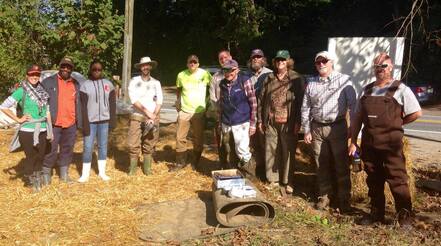Stream Restoration

The Jones Falls Restoration Project is the latest episode in MDTU’s long history of stewarding this special suburban/urban stream. Jones Falls is a spring-fed stream that has its primary source of spring water in the Greenspring Valley in Baltimore County. The watershed is relatively undeveloped with land use in the valley comprised primarily of large estates. The mainstem of Jones Falls flows approximately 6.5 miles east from Garrison Forest Road to Falls Road, where it turns south paralleling Falls Road for about 2.5 miles. Fish population surveys by the Maryland Department of Natural Resources Fisheries Service have documented the highest standing crop of wild trout of any stream in Maryland in the Jones Falls.
In 1973, MDTU joined forces with the Greenspring Valley Garden Club to adopt Jones Falls under the Save Our Streams, "Adopt a Stream" program. Activities over the years have included an annual litter cleanup, a water quality monitoring program in which students from seven schools in the Greenspring Valley were recruited and trained to collect water samples and make observations weekly to document water quality and habitat conditions. The chapter conducted an annual fish population survey, a watershed-wide stream walk, and a snapshot of the overall health of the watershed including macro-invertebrate collections and analysis of water samples. MDTU also conducted habitat improvement and bank stabilization projects in the reach downstream of Park Heights Avenue. MDTU has continued to organize volunteer stream clean-up events and engage landowners in stewardship efforts..

As part of the 2009-2014 MDTU Strategic Plan, the Chapter adopted the Jones Falls as its major resource effort. A major new new project focused on property owned by Baltimore City located on the west side of Falls Road immediately upstream of the Falls Road bridge.
The section of stream adjacent to the Baltimore City property had been channelized and lined with concrete. Approximately 600 feet of concrete channel eliminated any viable habitat for aquatic life. MDTU proposed to remove concrete and restore natural stream channel in this reach so that habitat could be restored using a natural channel design approach. The redesigned channel features stream banks vegetated with native plants as well as pools and riffle. The completed project creates outstanding habitat for trout and aquatic organisms that are associated with a healthy coldwater ecosystem.
Partners include Blue Water Baltimore, Baltimore County Department of Environmental Protection and Resource Management (DEPRM), Baltimore City Department of Recreation and Parks, the Maryland DNR Fisheries Service.
The Chesapeake and Coastal Bays Trust Fund provided funding, Jim Gracie and Brightwater, Inc. initiated the project concept and design; Blue Water Baltimore led the project to completion following the design phase, in partnership with Environmental Quality Resources.
The stream restoration work was concluded in 2016. Tree planting was completed shortly after and MDTU, who retained responsibility for monitoring, conducted the first trainings and survey in October, 2016.
Brown trout were observed holding in the restored section in October, 2016 and continue to thrive in the stream.
The section of stream adjacent to the Baltimore City property had been channelized and lined with concrete. Approximately 600 feet of concrete channel eliminated any viable habitat for aquatic life. MDTU proposed to remove concrete and restore natural stream channel in this reach so that habitat could be restored using a natural channel design approach. The redesigned channel features stream banks vegetated with native plants as well as pools and riffle. The completed project creates outstanding habitat for trout and aquatic organisms that are associated with a healthy coldwater ecosystem.
Partners include Blue Water Baltimore, Baltimore County Department of Environmental Protection and Resource Management (DEPRM), Baltimore City Department of Recreation and Parks, the Maryland DNR Fisheries Service.
The Chesapeake and Coastal Bays Trust Fund provided funding, Jim Gracie and Brightwater, Inc. initiated the project concept and design; Blue Water Baltimore led the project to completion following the design phase, in partnership with Environmental Quality Resources.
The stream restoration work was concluded in 2016. Tree planting was completed shortly after and MDTU, who retained responsibility for monitoring, conducted the first trainings and survey in October, 2016.
Brown trout were observed holding in the restored section in October, 2016 and continue to thrive in the stream.
Habitat Improvement
In March 2016, led by MDTU board member Jim Tingey, volunteers initiated a clean-up of the Upper Jones Falls watershed. Beginning at Stevenson Village and ending at Clark Farm, the team collected over 2,000 pounds of debris. Efforts have continued downstream, with the future goal of clean-up all the way to Meadowbrook Park. (2.1 miles of wild brown trout habitat.)
